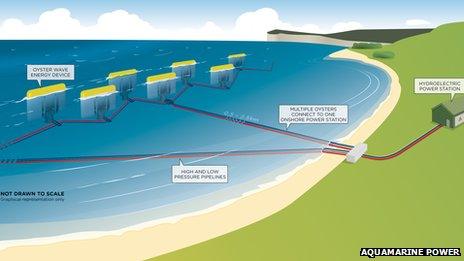Ministers approve plans for world's biggest wave farm in Western Isles
- Published

Aquamarine Power is currently testing its second full-scale wave machine, known as the Oyster 800, at the European Marine Energy Centre in Orkney
Ministers have approved plans for the world's largest commercial wave farm.
Full consent has been given for a 40MW farm off the north-west coast of Lewis - enough to power nearly 30,000 homes.
Wave energy firm Aquamarine Power said it would begin installing its Oyster devices in the next few years, once grid infrastructure is put in place.
Energy giant SSE said last week it would not be able to commission work on a Western Isles subsea electricity cable before 2017.
Aquamarine said it planned "ultimately" to deploy between 40 and 50 devices along the coast at Lag na Greine, near Fivepenny Borve.
The project will be carried out by Aquamarine subsidiary Lewis Wave Power Limited.
Last year, Comhairle nan Eilean Siar (Western Isles Council) gave planning permission for an onshore hydroelectric power plant which will be connected to the Oyster farm.

Aquamarine Power plans to build between 40 and 50 Oyster devices, after grid infrastructure is put in place
But last week SSE said it would not be able to commission work on an interconnector, which would transmit power generated by renewable projects on the Western Isles to customers on the mainland, before 2017.
Previously it had been suggested the £705m cable could be laid in 2015 and then 2016.
SSE said it has already spent £5m developing options for the interconnector.
Aquamarine is currently testing its second full scale wave machine, known as the Oyster 800, at the European Marine Energy Centre in Orkney, and is now producing electrical power to the grid.
'Significant milestone'
Chief executive Martin McAdam described the granting of planning permission for the farm as a "significant milestone" for the company.
He added: "The goal of our industry is to become commercial, and to do this we need two things - reliable technologies and a route to market.
"Our engineers are currently working hard on getting the technology right and we now have a site where we can install our first small farm, with a larger-scale commercial build out in the years ahead."
An animation has shown how the wave-powered pumps would work
Comhairle nan Eilean Siar leader Angus Campbell said it was excellent news for the Outer Hebrides.
He added: "It is vital that developing technology like that of Aquamarine Power is retained in Scotland but, for that, we need to extend our electricity grid into the areas of best resource.
"Aquamarine Power's announcement adds further weight to the call for our transmission owner, SSE, to move quickly on construction of this link for which there is so much consented demand," he added.
In a separate development, Energy Minister Fergus Ewing has announced that Scotland will be the first part of the UK to have a dedicated fund to help with the development of the wave energy sector.
Dedicated fund
Mr Ewing said the £18m Marine Renewables Commercialisation Fund (MRCF), which was launched last year, is now to be used to provide support for the wave energy industry.
Speaking at the All Energy Conference in Aberdeen, he revealed projects would be able to apply for cash from next month.
Funding is expected to be awarded this summer.
He said: "All previous marine energy funding schemes have been open to both wave and tidal projects.
"We are proposing something very different here in Scotland, making us the first in the UK."
Mr Ewing said the fact that three leading tidal energy projects in Scottish waters had recently secured financial support from other sources - a European Commission fund and a UK government scheme - gave the Scottish government "the prospect do something different with the MRCF".
He added: "Scotland needs both wave and tidal stream technologies to help decarbonise our electricity system, increase energy security and reduce dependence on imported fossil fuels."
Lang Banks, director of environmental charity WWF Scotland, hailed the move as a "very welcome and timely boost for the wave power industry in Scotland".
- Published22 May 2013
- Published17 May 2013
- Published8 April 2013
- Published4 March 2013
- Published20 December 2012
- Published28 August 2012